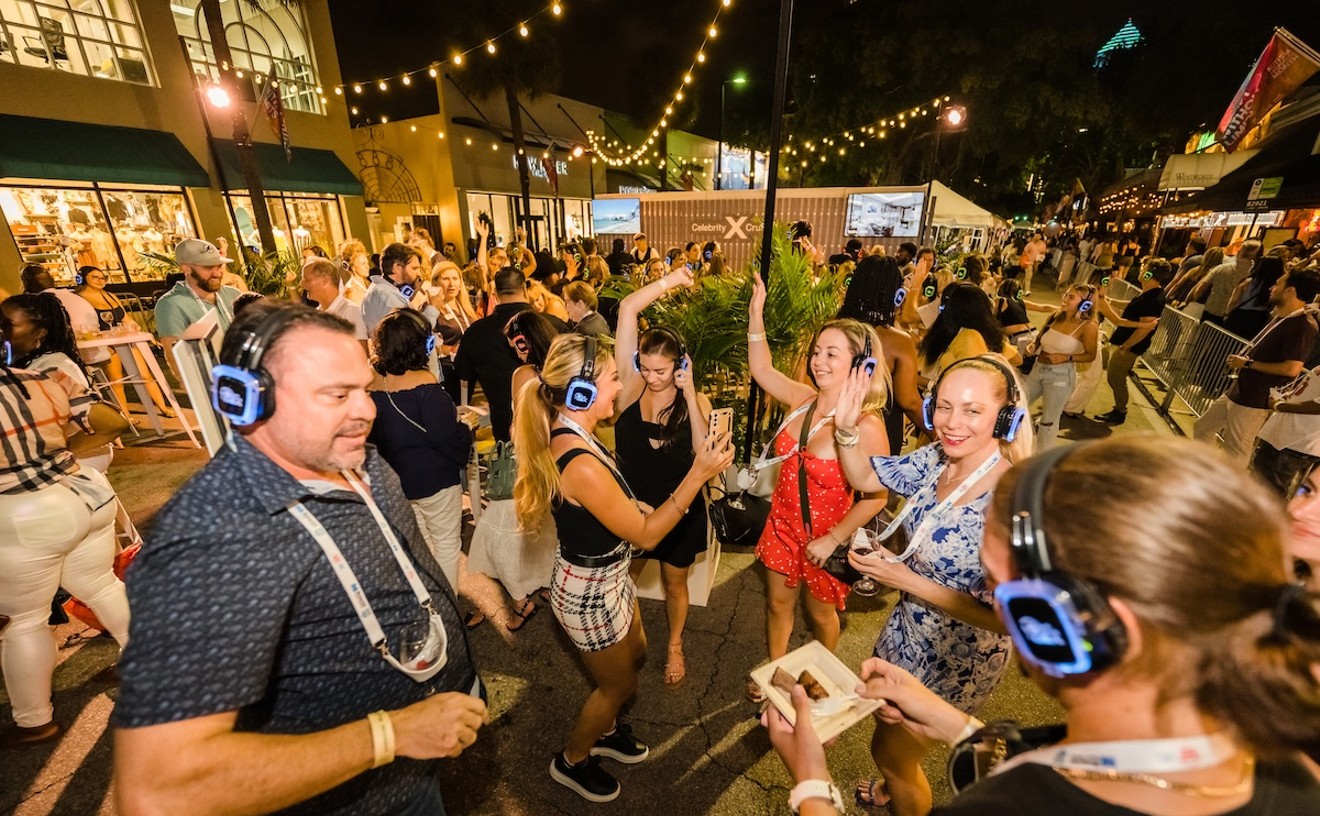When I read that, I felt like a Third Worlder wondering what these wonderful American places were really like. So I took a snapshot glimpse by selecting restaurant reviews from a random week, that of October 12 through October 19, choosing New York and Los Angeles to see how we stack up against the big guys, and Phoenix because it has more in common, sizewise, to the market here. Of course it's impossible to quantitatively compare dining scenes in different cities based solely on what a few reviews say, but their perusal does make one thing clear: Miami may not have the best restaurants in the nation but at least they're the most expensive.
Even those who make a living from promoting our restaurants concur. Dindy Yokel (DindyCo PR & Marketing) admits when she moved here from New York five years ago: “I was quite surprised that prices were closer to or the same as New York.” Larry Carrino (Susan Brustman & Associates) agrees that restaurants down here “do get away with hiking things up, particularly those on the Beach.” He also makes an important distinction: “A majority of the restaurants that charge exorbitant prices are not quality places, which gives a bad rap to those fine-dining restaurants that are.” This sentiment was echoed among many I talked with: They don't begrudge the cost of first-rate food and service but rather the overpriced mediocrity of midrange restaurants that pretend to offer that. And they bemoan the lack of good midrange eateries in general. “There are more neighborhood restaurants in New York that serve food that here would be considered fine dining,” notes Terry Zarikian (Shapiro & Zarikian, Inc.), who recalls a recent meal at just such a place in Manhattan called Red Cat. “I was able to have an appetizer and main course for under $30, and the food was like Mark's Place. You don't find that here.”
The pricing/quality problem may rest mainly in our so-called regular restaurants, but a look at sample reviews from across the nation reveals that Miami's fine-dining establishments have a habit of overcharging as well.
We begin in the Big Apple, where New York Times restaurant reviewer William Grimes, dining at the landmark French restaurant Le Périgord, enjoyed a terrine of Arctic char, the troutlike fish “ingeniously wrapped in a fish-stock-and-herb gelée so that each slice, flavored with coconut emulsion and ginger oil, comes out in a pattern of four pink squares defined by a thick green border.” Le Périgord has operated on 52nd Street in Manhattan for 35 years. Weigh it against Touch, which has been on Lincoln Road for closer to 35 days. Not a fair comparison? Possibly, except for the fact that it costs more to eat at Touch than it does at Le Périgord. The latter's appetizers top out at $15, which means the char terrine, as well as a foie gras terrine marbled with celeriac and topped with a gelée made with vin de paille, both cost at least $3 less than Touch's high-end starters. Even a greater disparity exists between entrées: Le Périgord's run from $22 to $30, and they offer a three-course prix-fixe dinner for $32. At Touch? Filet: $37. Veal chop: $38. Rack of lamb: $39.
A restaurant's track record is one means of gauging the credibility of its prices. Another is the background of its chef, which ultimately factors into the quality of cuisine. Jacques Qualin, the man running the kitchen at Le Périgord, previously spent several years cooking at a pair of New York's best restaurants, JoJo and Jean Georges. Chef Sean Brasel also brings stellar credentials with him to Touch, having shined at some of Denver's most highly regarded dining establishments. We can call that a draw, and, to be extremely kind, we can forget about service in these comparisons. We all know, however, that if Miami restaurants, particularly on the Beach, have any national reputation at all, it's that of offering particularly bad service.
In Phoenix the Arizona Republic's food critic Howard Seftel dined on “grilled trout teaming with red and yellow cherry tomato and tarragon salsa with a marvelous potato-leek gratin” at a highly rated midrange neighborhood eatery, the Ridge Cafe. The cost for that meal was $16, or $3 less than ahi tuna at Brickell's brewpub Gordon Biersch, and $1 less than shrimp fajitas at Tequila Sunrise in the Gables. Seftel also savored “an Asian-style mix of mussels, shrimp, clams, calamari, and sweet Chinese sausage, served over noodles in a broth infused with lemon grass and ginger” for $17. At the Pelican on Ocean Drive, a more common combination of shrimp, octopus, mussels, and marinara sauce over spaghetti costs $18.90. It's $14 for only clams and linguini at the primarily pizzeria Pizza e Via on Lincoln Road. Heck, the $22 rack of lamb at the Ridge costs just $4 more than lamb chops at that pizzeria. More perspective: $22 will buy you osso buco at Baraboo but you'd need $6 more for baby-back ribs at Yuca, and $3 more if you wanted rack of lamb at Pascal's on Ponce, which has been lauded for keeping prices down. (It should be noted that Pascal's as well as Liaison are two recent steps in the right direction toward affordable, quality neighborhood dining.)
Why the local inflation? That midrange Miami restaurants “charge more than a market such as Phoenix,” explains publicist Yokel, “is because those who live in Miami, most specifically on the Beach, suffer from pricing that is directed at the tourists. Tourist markets around the world charge more than other markets.” She adds that this is “not great for the average person; that's why fast-food restaurants prosper and the midrange restaurants struggle or go out of business.” Tourism has another effect on steepening our prices: Locals must pay more so Miami's restaurant owners can recoup money lost during the off-season. In other words, they've only got six months max to attain the profits that restaurants in other cities have twelve months to achieve. But if that logic held true outside the dining world, we'd be paying $12 to see a movie so that theater owners here could make as much as those in year-round markets. Lord only knows how much more we'd have to cough up for a car.
Movies, cars, and Asian restaurants bring us to Southern California, where Jonathan Gold of Los Angeles Magazine, lucky dog, got to dine at two venerable venues in one week: Le Colonial and Mr. Chow's. At the former he luxuriated in a starter of steamed duck and mushroom ravioli “as gourmet as anything you'd get in Milan” for $8.50, following by a main course of “cubed filet mignon in spicy peanut sauce with yams, long beans, and basil” for $21. The chef is Mako Trinidad Antonishek, a Culinary Institute of America graduate who previously cut her chops at two New York shrines, Mesa Grill and Gramercy Tavern. Bambù is similar in cuisine and ambiance to Le Colonial and also has a respectable chef in Norman protégé Rob Deer. The least expensive appetizer here is grilled tofu, spinach, and dipping sauce for $9, with most starters between $13 and $28; main plates go from $25 to $44. Bambù, of course, would fall into Carrino's classification of a quality restaurant, and he mentions that “many of their ingredients are exotic imports -- for instance one of the berries they use grows only in Japan, so they have to fly batches in.” Valid point, especially in explaining why Bambù is more extravagantly priced than other local pan-Asian places. But it's still surprising to find them charging more than Le Colonial, which, according to their review, doesn't skimp on ingredients either.
You can peer through the glass-walled kitchen at Mr. Chow's and watch an army of experienced Chinese chefs knead dumpling dough and shape noodles by hand (a bowl of those noodles, with broth and vegetables, goes for $12.50). Gold describes this legendary spot, which has been home to star clientele since 1968, as “one of the most urbane and theatrical dining experiences in town.” Dover sole, “impeccably steamed in rice wine with sea mushrooms,” goes for $22.50; filet mignon and asparagus in red-wine sauce is $26. While Gold gripes that “the only real problem with Mr. Chow is the price tag,” one can understand how after 32 years prices can creep up a bit. Compare it with less-than-one-year-old Opium, where whole crispy snapper with chili sauce is $26, Szechuan peppercorn-crusted filet with wasabi potatoes and asparagus, $32.
So blame our inflated prices on the tourist trade, but don't point the finger at high real estate costs: Le Colonial and Mr. Chow are both located in Beverly Hills. Next time you get really fed up with dining out in Miami, think about moving to the apparently more affordable home of the stars.











